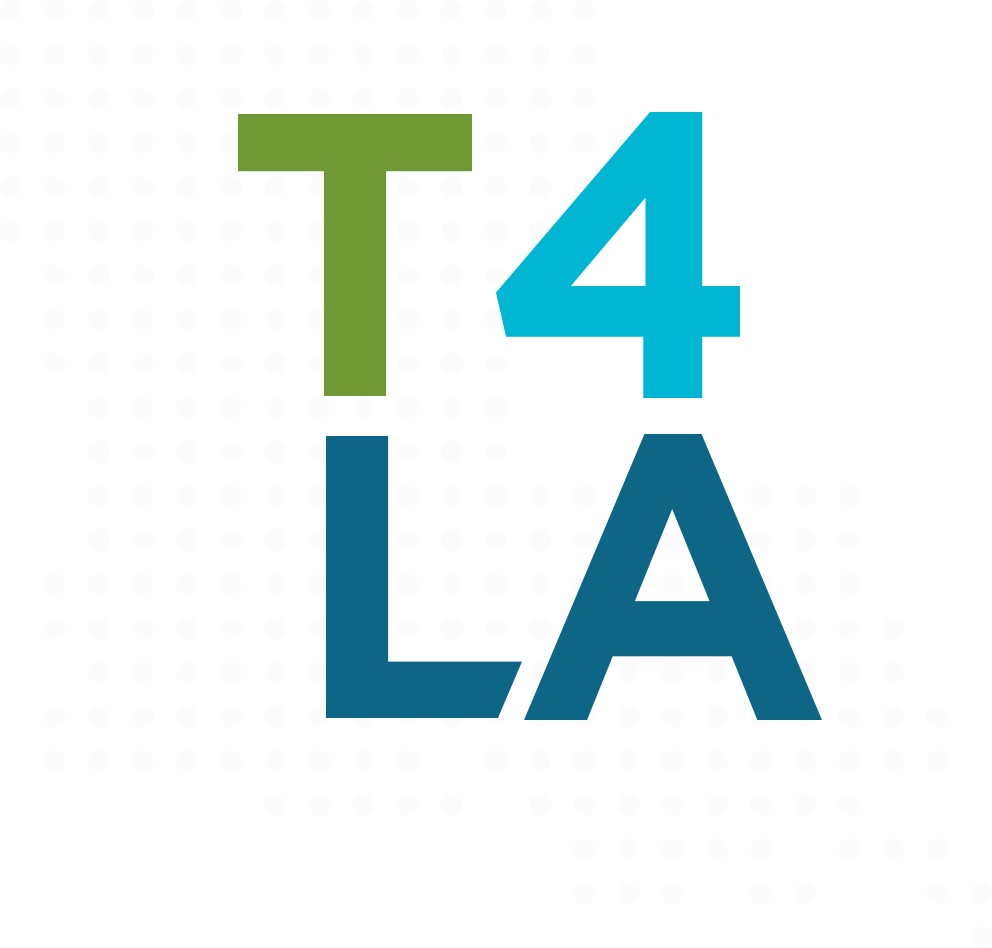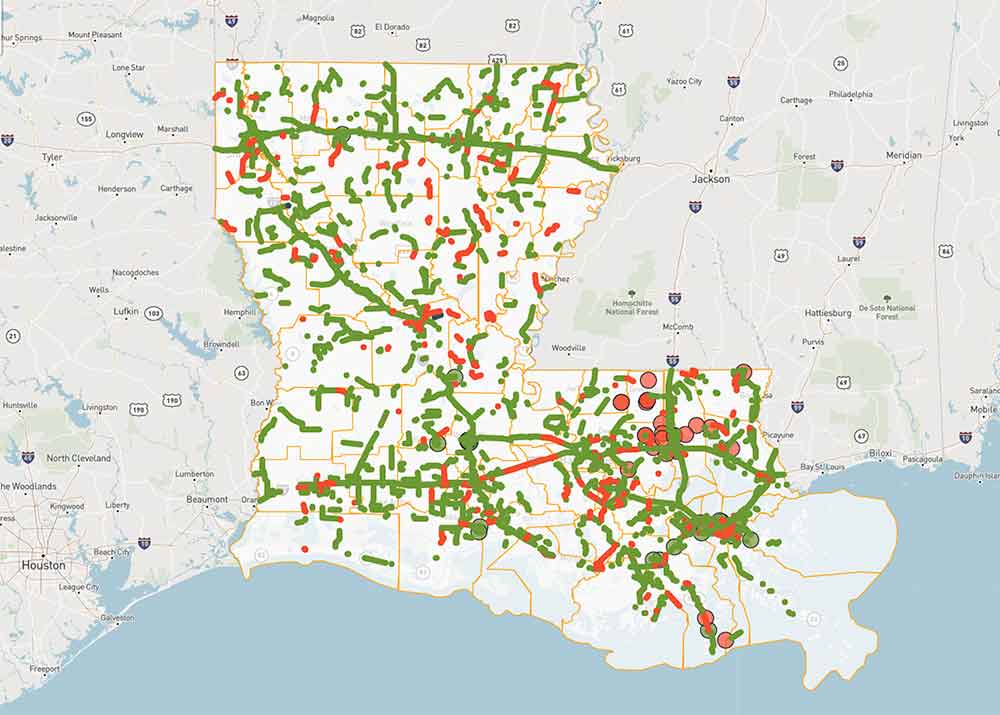Driving Change
LADOTD's Plan for Transforming Transportation
Our Vision Video Initiatives Project Viewer



Sparked by Governor Jeff Landry’s executive order, the T4LA initiative—Transforming Transportation with Transparency and Teamwork—is currently underway at the Louisiana Department of Transportation and Development. LADOTD has been tasked with transforming the organization from within. And that’s exactly what we are working to do through T4LA. We are reshaping how we serve the people of our state by enhancing our operations both internally and externally. LADOTD will advance and strengthen transportation for our state with greater transparency and accountability, driving economic development and growth across Louisiana.
T4LA at a Glance


Description: This initiative will revise DOTD’s business processes for selecting projects to include in the annual Highway Priority Program (HPP) and the early steps in advancing those projects. The goal is to ensure the HPP is consistently delivered as promised while also allocating funding based on objective project assessments that include statutory requirement, hard data, citizen demand, and economic development.
Project Prioritization
Statewide Transportation Improvement Plan (STIP)
Communication of HPP
Description: This initiative will modernize current project management processes, procedures, and organization structure by aligning DOTD with peer-state best practices. Training will be developed and provided to ensure that staff have a comprehensive understanding of the roles and responsibilities of a Project Manager.
Project Manager Roles and Responsibilities
Project Management Discipline
Description: This initiative will overhaul the current Project Delivery process and integrate DOTD best practices into Rawlins’ proven project delivery network (PDN) framework. The PDN is a framework that outlines steps, activities, tasks, and deliverables to provide consistency and transparency throughout the project delivery process, enabling project teams to improve reliability and efficiency through coordination, cooperation, and alignment.
Description: This initiative will pursue innovative means to improve deficient bridges and enhance the program’s efficiency and streamline processes to ensure the long-term success of DOTD’s bridge preservation program.
Description: This initiative began with developing three regional bundled bridge packages to accelerate repair and replacement of closed and posted bridges and now includes the support of all projects undertaken by the OLHC.
A notice of intent was issued for the program, but an RFQ was not issued because the responsibility for these bridges was transferred to the Office of Louisiana Highway Construction. DOTD will support the OLHC as requested. The RFQ and PDB Contract were not finalized. The team intends to convert the bridge bundle specific RFQ and PDB Contract to template documents so DOTD is ready in the event PDB is used by DOTD in the future.
Description: This initiative will analyze DOTD’s Local Public Agency (LPA) Program business processes and organizational structure to ensure the program complies with federal and state requirements and results in the LPAs delivering the projects programmed in the Highway Priority Program (HPP).
Description: This initiative will improve the administration of DOT’s maintenance program. Improvement will focus on refining how infrastructure conditions are assessed, and resources are allocated to provide the highest return on investment. The initiative will include enhancement of the training program to facilitate consistent maintenance practices across the state and training of maintenance staff. The initiative will also assess how the maintenance workforce is utilized to determine the appropriate level of maintenance contracting. New maintenance contracting methods will be implemented as part of the IDIQ initiative.
Description: This initiative will improve DOTD’s administration of its construction program. Improvement will focus on construction processes and requirements related to construction specifications, change orders, contractor payment, conflict resolution, and construction cost accounting. Improvements will consider national best practices identified through a review of peer DOT processes. Reorganizational efforts that are in progress will be reviewed, and additional reorganization may be incorporated. Training will be developed, and staff will be trained to facilitate consistency in construction administration throughout that state.
Description: The initiative will provide additional options for delivery of DOTD construction and maintenance projects through development of procedures for Indefinite Delivery Indefinite Quantity (IDIQ) contracting. IDIQ contracting provides for an indefinite quantity of supplies or services during a fixed period, allowing DOTD to procure goods and services when the exact quantities and delivery schedules are not known.
Description: This initiative will improve the consultant contract administration process to reduce delays in the letting process and centralize administrative functions.
Description: This initiative will review current funding programs and processes for ports, waterways, passenger rail, and aviation.
Description: This initiative will develop comprehensive department, office, and section-level Key Performance Indicators (KPIs). Development will include identifying national best practices in alignment with DOTD goals and objectives. The development of comprehensive KPIs and identification of the data sources necessary for reporting will include coordination with all impacted offices, sections, program managers, teams, and DOTD’s ongoing efforts related to data governance.
Description: This initiative implements the Smart PM system in support of the newly developed Critical Path Method (CPM) Construction Spec. Smart PM provides statewide standardization by allowing all contractors and project engineers to work from the same information in the form of 35 standard objective criteria.
Description: This initiative will address two major needs, Data Governance and Advanced Digital Solutions. DOTD will identify and adopt advanced technologies and digital solutions (including artificial intelligence, advanced analytics, and robotics solutions) to deliver measurable efficiency gains and cost-savings, while also improving public-facing services. DOTD will review effective solutions that other transportation agencies and the private sector are deploying around the world and evaluate the current capabilities and readiness to integrate these tools to select and integrate solutions that are both feasible and high impact.
DOTD will also improve the accuracy and reliability of LADOTD data and create sustainable governance, so data is managed in a consistent way, accessible by the right people, understood and trusted by the department for decisions, reports, sharing externally, and answering questions.
Description: This initiative will streamline and provide transparency to the Right of Way permit process. With the assistance of ESRI, DOTD will eliminate tedious paper applications and provide an online system for the intake and processing of Right of Way (ROW) permits. This system will allow a landowner to submit a permit application and follow its progress through the review and approval process. Constant transparency throughout the process will allow internal and external stakeholders to monitor progress, identify roadblocks, and provide accountability. This will also streamline communications between district and HQ.
Description: This initiative was the direct result of working with DOTD’s transition team partners. With assistance from the River Pilot’s Association and NOAA, DOTD secured funding and is facilitating the upgrading of Crescent City Connection Bridge air gap measurement sensors and the addition of air gap measurement systems at 5 additional locations: Horace Wilkinson Bridge, Hale Boggs Bridge, Gramercy Bridge, Huey P. Long Bridge, and Sunshine Bridge. Each location includes a primary and backup air gap sensor, two independent data collection platforms (DCPs) for each sensor.
Description: This initiative is a coordinated effort between DOTD and OTS to upgrade from Office 2016 to provide modern work tools, including Teams and CoPilot AI, available in the latest Microsoft Office suite.
Description: This initiative will centralize and formalize the processes DOTD used for accepting and processing system work requests. A new online portal will collect work requests, track them through the work order process and automate some of the reporting and public engagement functions. The effort is intended to improve customer service, increase transparency, and more efficiently process the thousands of monthly work requests received by the department.
Description: This initiative modernized the public-facing DOTD website, with a key feature being the Project Viewer. The Project Viewer allows DOTD stakeholders to see updates for current and planned DOTD construction projects.
Description: This initiative will implement a new tool for the development and maintenance of project schedules in the Highway Priority Program (HPP), as well as the rollout of a new Project Status Reporting system. A software solution has been developed to interface DOTD’s current SAP-based project tracking tool with an expanded project scheduling tool, based on the Critical Path Method (CPM) of project delivery. Project data derived from user inputs and newly developed project scheduling templates, as well as behind-the-scenes CPM scheduling operations will be presented on the Project Status Report dashboard, which will support in the delivery of the HPP by providing decision makers with the latest project-related data.
Description: This initiative will include an ongoing effort to provide proactive communications that support all T4LA initiatives.
Description: This initiative will include the revision of the DOTD organizational structure to create the offices of Project Delivery and Transformation while promoting general operational efficiency.
Description: This initiative addresses multiple facets of how DOTD addresses Human Resource functions.
Description: DOTD personnel, including legal staff and subject matter experts, are performing a comprehensive review of DOTD’s administrative rules and other policy documents to ensure consistency, clarity, and compliance with legal requirements.
TITLE 46 PROFESSIONAL AND OCCUPATIONAL STANDARDS
Part LXXXJX. Water Well Contractors (Drillers)
TITLE 70 TRANSPORTATION AND DEVELOPMENT
Part I. Highway Construction
Part II. Utilities
Part III. Outdoor Advertising
Part VIL Offshore Terminal Authority
Part IX. Intermodal Transportation
Part XVII. Real Estate
Part XIX. Compliance Programs
TITLE 73 WEIGHTS, MEASURES AND STANDARDS
Part I. Weights and Standards
Description: This initiative will fully implement the Interim Final Rule (IFR) issued by the U.S. Department of Transportation, which took effect on October 3, 2025. In coordination with members of the Louisiana Unified Certification Program (LAUCP) that consists of the New Orleans Regional Transit Authority and the New Orleans International Airport, the Compliance Programs Section will establish a detailed implementation plan. This will include a timeline, specific action steps, a checklist, a standardized narrative form, and updated standard operating procedures to address the following:
Description: This initiative will develop departmental policy and procedures necessary for the support of large economic developments and whole of government coordination.
Description: This initiative will study Departmental opportunities for alternative revenue streams including, but not limited to, Public Private Partnerships (P3), Tolling Opportunities, Land Leasing for Cell Towers and Other Utility Infrastructure, Sponsorships and Naming Rights, Shared Maintenance Agreements with Other State Agencies and Local Municipalities.
Description: This initiative relocates DOTD’s Public Works Section from the Office of Project Delivery to a new Office of Public Works, aligning structure and authority with Act 418 (2025), which established the CURRENT Authority to coordinate upland watershed management, drainage, and resilience planning. The reorganization consolidates floodplain management, NFIP coordination, watershed modeling, and infrastructure planning into a unified operational framework. It preserves DOTD’s historical technical leadership while formalizing its role as Louisiana’s custodian of watershed models and future LOMR-Delegated Entity under FEMA Region 6.
Description: This initiative will utilize best practices from neighboring states as well as take guidance from Louisiana DOGE, DOA, and LLA.

Check out our interactive map to see the latest LADOTD projects in your area—scheduled, under construction, or completed.
Project Viewer »Be the first to hear T4LA updates and stay informed on LADOTD's transportation transformation in Louisiana.